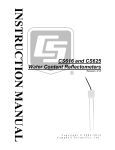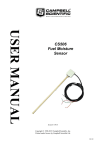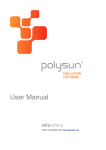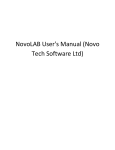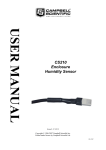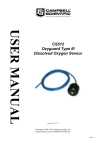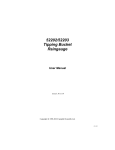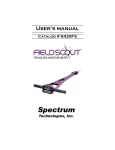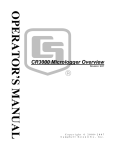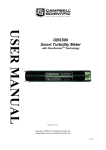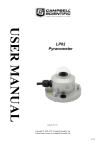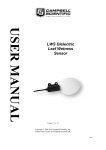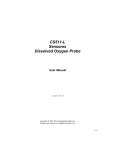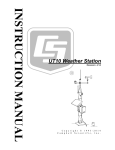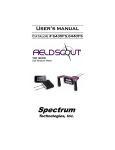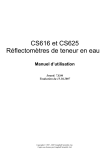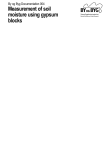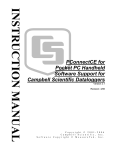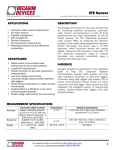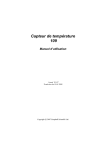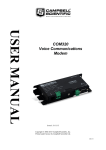Download CS616 & CS625 Water Content Reflectometers
Transcript
USER MANUAL CS616 & CS625 Water Content Reflectometers Issued: 11.8.15 Copyright © 2002-2015 Campbell Scientific, Inc. Printed under licence by Campbell Scientific Ltd. CSL 467 Guarantee This equipment is guaranteed against defects in materials and workmanship. This guarantee applies for 24 months from date of delivery. We will repair or replace products which prove to be defective during the guarantee period provided they are returned to us prepaid. The guarantee will not apply to: Equipment which has been modified or altered in any way without the written permission of Campbell Scientific Batteries Any product which has been subjected to misuse, neglect, acts of God or damage in transit. Campbell Scientific will return guaranteed equipment by surface carrier prepaid. Campbell Scientific will not reimburse the claimant for costs incurred in removing and/or reinstalling equipment. This guarantee and the Company’s obligation thereunder is in lieu of all other guarantees, expressed or implied, including those of suitability and fitness for a particular purpose. Campbell Scientific is not liable for consequential damage. Please inform us before returning equipment and obtain a Repair Reference Number whether the repair is under guarantee or not. Please state the faults as clearly as possible, and if the product is out of the guarantee period it should be accompanied by a purchase order. Quotations for repairs can be given on request. It is the policy of Campbell Scientific to protect the health of its employees and provide a safe working environment, in support of this policy a “Declaration of Hazardous Material and Decontamination” form will be issued for completion. When returning equipment, the Repair Reference Number must be clearly marked on the outside of the package. Complete the “Declaration of Hazardous Material and Decontamination” form and ensure a completed copy is returned with your goods. Please note your Repair may not be processed if you do not include a copy of this form and Campbell Scientific Ltd reserves the right to return goods at the customers’ expense. Note that goods sent air freight are subject to Customs clearance fees which Campbell Scientific will charge to customers. In many cases, these charges are greater than the cost of the repair. Campbell Scientific Ltd, 80 Hathern Road, Shepshed, Loughborough, LE12 9GX, UK Tel: +44 (0) 1509 601141 Fax: +44 (0) 1509 601091 Email: [email protected] www.campbellsci.co.uk PLEASE READ FIRST About this manual Please note that this manual was originally produced by Campbell Scientific Inc. primarily for the North American market. Some spellings, weights and measures may reflect this origin. Some useful conversion factors: Area: 1 in2 (square inch) = 645 mm2 Length: 1 in. (inch) = 25.4 mm 1 ft (foot) = 304.8 mm 1 yard = 0.914 m 1 mile = 1.609 km Mass: 1 oz. (ounce) = 28.35 g 1 lb (pound weight) = 0.454 kg Pressure: 1 psi (lb/in2) = 68.95 mb Volume: 1 UK pint = 568.3 ml 1 UK gallon = 4.546 litres 1 US gallon = 3.785 litres In addition, while most of the information in the manual is correct for all countries, certain information is specific to the North American market and so may not be applicable to European users. Differences include the U.S standard external power supply details where some information (for example the AC transformer input voltage) will not be applicable for British/European use. Please note, however, that when a power supply adapter is ordered it will be suitable for use in your country. Reference to some radio transmitters, digital cell phones and aerials may also not be applicable according to your locality. Some brackets, shields and enclosure options, including wiring, are not sold as standard items in the European market; in some cases alternatives are offered. Details of the alternatives will be covered in separate manuals. Part numbers prefixed with a “#” symbol are special order parts for use with non-EU variants or for special installations. Please quote the full part number with the # when ordering. Recycling information At the end of this product’s life it should not be put in commercial or domestic refuse but sent for recycling. Any batteries contained within the product or used during the products life should be removed from the product and also be sent to an appropriate recycling facility. Campbell Scientific Ltd can advise on the recycling of the equipment and in some cases arrange collection and the correct disposal of it, although charges may apply for some items or territories. For further advice or support, please contact Campbell Scientific Ltd, or your local agent. Campbell Scientific Ltd, Campbell Park, 80 Hathern Road, Shepshed, Loughborough, LE12 9GX, UK Tel: +44 (0) 1509 601141 Fax: +44 (0) 1509 601091 Email: [email protected] www.campbellsci.co.uk Contents PDF viewers: These page numbers refer to the printed version of this document. Use the PDF reader bookmarks tab for links to specific sections. 1. Introduction ................................................................ 1 2. Cautionary Statements .............................................. 1 3. Initial Inspection ........................................................ 1 4. Quickstart ................................................................... 2 5. Overview ..................................................................... 4 6. Specifications ............................................................ 5 6.1 6.2 6.3 6.4 Dimensions .......................................................................................... 5 Weight .................................................................................................. 5 Electrical Specifications ....................................................................... 6 Operational Details .............................................................................. 6 7. Installation .................................................................. 7 7.1 7.2 7.3 7.4 Orientation ........................................................................................... 7 Potential Problems with Improper Insertion ........................................ 7 Wiring .................................................................................................. 7 Datalogger Programming ..................................................................... 8 7.4.1 CS616 CRBasic Programming...................................................... 8 7.4.2 CS625 CRBasic Programming...................................................... 9 8. Operation .................................................................. 10 8.1 Water Content Reflectometer Method for Measuring Volumetric Water Content ................................................................................. 10 8.1.1 Response Curves ......................................................................... 10 8.1.2 Calibration Equations.................................................................. 12 8.1.3 Operating Range ......................................................................... 14 8.1.3.1 Soil Electrical Conductivity ............................................. 14 8.1.3.2 Soil Organic Matter, Clay Content, and Soil Bulk Density.......................................................................... 15 8.1.4 Error Sources in Water Content Reflectometer Measurement .... 15 8.1.4.1 Probe-to-Probe Variability Error ...................................... 15 8.1.4.2 Insertion Error .................................................................. 15 8.1.4.3 Signal Attenuation Error .................................................. 16 8.1.5 Temperature Dependence and Correction ................................... 16 8.2 Water Content Reflectometer User-Calibration ................................. 17 8.2.1 Signal Attenuation in Conductive Soils and Need for SiteSpecific Calibration ................................................................. 17 8.2.2 User-Derived Calibration Equation ............................................ 18 8.2.3 Collecting Laboratory Data for Calibration ................................ 18 8.2.4 Collecting Field Data for Calibration .......................................... 21 8.2.5 Calculations ................................................................................ 23 9. Maintenance ............................................................. 23 i 10. References ............................................................... 23 Appendices A. Discussion of Soil Water Content......................... A-1 B. Importing Short Cut Code ..................................... B-1 C. Example Programs ................................................ C-1 C.1 CS616 Programs .............................................................................. C-1 C.1.1 CR1000 Program for Measuring Eight CS616 Probes ............. C-1 C.1.2 CR1000/Multiplexer Program for Measuring 48 CS616 Probes .................................................................................... C-3 C.2 CS625 Programs .............................................................................. C-5 C.2.1 CR200(X) Program for Measuring Four CS625 Probes ........... C-5 C.2.2 CR200(X) Program with Temperature Correction ................... C-6 Figures 7-1. 8-1. 8-2. 8-3. 8-4. Water content reflectometer wires ....................................................... 8 CS616 and CS625 linear and quadratic calibrations derived from loam soil ......................................................................................... 11 CS616 response for different soil types ............................................. 12 Linear versus quadratic calibration differences ................................. 13 Percent volumetric water content error adjusted with temperature correction equation ......................................................................... 17 Tables 7-1. 8-1. 8-2. 8-3. C-1. C-2. C-3. C-4. C-5. Datalogger/Reflectometer Wiring. ....................................................... 7 Standard calibration coefficients for linear and quadratic forms ....... 13 Calibration coefficients for sandy clay loam with bulk density 1.6 g cm–3 and electrical conductivity at saturation 0.4 dS m–1 for both linear and quadratic forms. ............................................... 14 Calibration coefficients for sandy clay loam with bulk density 1.6 g cm–3 and electrical conductivity at saturation 0.75 dS m–1 for both linear and quadratic forms. ............................................... 14 Datalogger Connection for Eight CS616s Example Program .......... C-1 Wiring for CR1000/Multiplexer Example ....................................... C-3 Wiring for CR200(X) Program Measuring Four CS625 Probes ...... C-5 CS625 Wiring for CR200X Program with Temperature Correction ..................................................................................... C-6 109 Wiring for CR200X Program with Temperature Correction .... C-6 ii CS616 and CS625 Water Content Reflectometers 1. Introduction The CS616 Water Content Reflectometer is an improved version of the CS615 Water Content Reflectometer. The CS625 is a modified CS616 for use with the CR200(X)-series dataloggers. The difference between the CS616 and the CS625 is the output voltage level. Both water content reflectometers are designed to measure volumetric water content (VWC) of soils or other porous media. The water content information is derived from the probe sensitivity to the dielectric constant of the medium surrounding the probe rods. NOTE 2. 3. This manual provides information only for CRBasic dataloggers. It is also compatible with several of our retired Edlog dataloggers. For Edlog datalogger support, see an older manual at www.campbellsci.com/old-manuals or contact a Campbell Scientific application engineer for assistance. Cautionary Statements Although the CS616/CS625 is rugged, it should be handled as precision scientific instrument. External RF sources can affect CS616/CS625 measurements. Consequently, the CS616/CS625 circuitry should be located away from significant sources of RF such as ac power lines and motors. CS616/CS625 probes enabled simultaneously and within approximately 9 inches of each other can cause erratic measurements. If probes must be close to each other, configure the enable lines to the datalogger control ports so that the probes are not enabled simultaneously. Initial Inspection Upon receipt of the CS616/CS625, inspect the packaging and contents for damage. File damage claims with the shipping company. The model number and cable length are printed on a label at the connection end of the cable. Check this information against the shipping documents to ensure the expected product and cable length are received. 1 CS616 and CS625 Water Content Reflectometers 4. Quickstart Short Cut is an easy way to program your datalogger to measure the CS616 or CS625 probe and assign datalogger wiring terminals. The following procedure shows using Short Cut to program the CS616. The procedure for the CS625 is similar. 2 1. Install Short Cut by clicking on the install file icon. Get the install file from either www.campbellsci.com, the ResourceDVD, or find it in installations of LoggerNet, PC200W, PC400, or RTDAQ software. 2. The Short Cut installation should place a shortcut icon on the desktop of your computer. To open Short Cut, click on this icon. 3. When Short Cut opens, select New Program. User Manual 4. Select Datalogger Model and Scan Interval (default of 5 seconds is OK for most applications). Click Next. 5. Under the Available Sensors and Devices list, select the Sensors | Soil Moisture folder. Select CS616 Water Content Reflectometer. Click to move the selection to the Selected device window. It defaults to measuring the sensor hourly. This can be changed by clicking the Measure Sensor box and selecting Every Scan. 3 CS616 and CS625 Water Content Reflectometers 5. 6. After selecting the sensor, click at the left of the screen on Wiring Diagram to see how the sensor is to be wired to the datalogger. The wiring diagram can be printed out now or after more sensors are added. 7. Select any other sensors you have, then finish the remaining Short Cut steps to complete the program. The remaining steps are outlined in Short Cut Help, which is accessed by clicking on Help | Contents | Programming Steps. 8. If LoggerNet, PC400, RTDAQ, or PC200W is running on your PC, and the PC to datalogger connection is active, you can click Finish in Short Cut and you will be prompted to send the program just created to the datalogger. 9. If the sensor is connected to the datalogger, as shown in the wiring diagram in step 6, check the output of the sensor in the datalogger support software data display to make sure it is making reasonable measurements. Overview The water content reflectometer consists of two stainless steel rods connected to a printed circuit board. A shielded four-conductor cable is connected to the circuit board to supply power, enable the probe, and monitor the pulse output. The circuit board is encapsulated in epoxy. High-speed electronic components on the circuit board are configured as a bistable multivibrator. The output of the multivibrator is connected to the probe rods which act as a wave guide. The travel time of the signal on the probe rods depends on the dielectric permittivity of the material surrounding the rods and the dielectric permittivity depends on the water content. Therefore, the oscillation frequency of the multivibrator is dependent on the water content of the media being measured. Digital circuitry scales the multivibrator output to an appropriate frequency for measurement with a datalogger. The water content reflectometer output is essentially a square wave. The probe output period ranges from about 14 microseconds with rods in air to about 42 microseconds with the rods 4 User Manual completely immersed in typical tap water. A calibration equation converts period to volumetric water content. The CS616/CS625’s cable can terminate in: 6. Pigtails that connect directly to a Campbell Scientific datalogger (option –PT). Connector that attaches to a prewired enclosure (option –PW). Refer to www.campbellsci.com/prewired-enclosures for more information. Specifications Features: High accuracy and high precision Fast response time Designed for long-term, unattended water content monitoring Probe rods can be inserted from the surface or buried at any orientation to the surface CS616 compatible with Campbell Scientific CRBasic dataloggers: CR6, CR80, CR850, CR1000, CR3000, and CR5000 CS625 compatible with Campbell Scientific CRBasic dataloggers: CR200X series and CR200 series Probe-to-Probe Variability: ±0.5% VWC in dry soil, ±1.5% VWC in typical saturated soil 6.1 6.2 Resolution: better than 0.1% VWC Water Content Accuracy: ±2.5% VWC using standard calibration with bulk electrical conductivity 0.5 deciSiemen per metre (dS m–1) and bulk density 1.55 g cm–3 in measurement range 0% to 50% VWC Precision: better than 0.1% VWC Dimensions Rods: 300 mm (11.8 in) long, 3.2 mm (0.13 in) diameter, 32 mm (1.3 in) spacing Probe Head: 85 x 63 x 18 mm (3.3 x 2.5 x 0.7 in) Probe (without cable): 280 g (9.9 oz) Cable: 35 g m–1 (0.38 oz per ft) Weight 5 CS616 and CS625 Water Content Reflectometers 6.3 Electrical Specifications Output CS616: CS625: Power: 0.7 volt square wave with frequency dependent on water content 0 to 3.3 volt square wave with frequency dependent on water content 65 mA @ 12 Vdc when enabled, 45 A quiescent Power Supply Requirements: 5 Vdc minimum, 18 Vdc maximum Enable Voltage: 4 Vdc minimum, 18 Vdc maximum Maximum Cable Length: 305 m (1000 ft) Electromagnetic Compatibility: 6.4 The CS616/CS625 is Œ compliant with performance criteria available upon request. RF emissions are below EN55022 limits if the CS616/CS625 is enabled less than 0.6 ms and measurements are made at a 1 Hz (1 per second) or slower frequency. The CS616/CS625 meets EN61326 requirements for protection against electrostatic discharge and surge. Operational Details The accuracy specification for the volumetric water content measurement using the CS616/CS625 probes is based on laboratory measurements in a variety of soils and over the water content range air dry to saturated. The soils were typically sandy loam and coarser. Silt and clay were present in some of the soils used to characterize accuracy. Resolution is the minimum change in the dielectric permittivity that can reliably be detected by the water content reflectometer. The CS616 or CS625 is typically used to measure soil volumetric water content. Precision describes the repeatability of a measurement. It is determined for the CS616 and CS625 by taking repeated measurements in the same material. The precision of the CS616/CS625 is better than 0.1 % volumetric water content. Soil Properties The water content reflectometer operation can be affected when the signal applied to the probe rods is attenuated. The probe will provide a wellbehaved response to changing water content, even in attenuating soils or other media, but the response may be different than described by the standard calibration. Consequently, a unique calibration is required. Change in probe response can occur when soil bulk electrical conductivity is greater than 0.5 dS m–1. The major contributor to soil electrical conductivity is the presence of free ions in solution from dissolution of soil salts. Soil organic matter and some clays can also attenuate the signal. 6 User Manual 7. Installation 7.1 Orientation The probe rods can be inserted vertically into the soil surface or buried at any orientation to the surface. A probe inserted vertically into a soil surface will give an indication of the water content in the upper 30 cm of soil. The probe can be installed horizontal to the surface to detect the passing of wetting fronts or other vertical water fluxes. A probe installed at an angle of 30 degrees with the surface will give an indication of the water content of the upper 15 cm of soil. 7.2 Potential Problems with Improper Insertion The method used for probe installation can affect the accuracy of the measurement. The probe rods should be kept as close to parallel as possible when installed to maintain the design wave guide geometry. The sensitivity of this measurement is greater in the regions closest to the rod surface than at distances away from the surface. Probes inserted in a manner which generates air voids around the rods will reduce the measurement accuracy. In most soils, the soil structure will recover from the disturbance during probe insertion. In some applications, installation can be improved by using the CS650G insertion guide tool. The CS650G is inserted into the soil and then removed. This makes proper installation of the water content reflectometer easier in dense or rocky soils. 7.3 Wiring Table 7-1. Datalogger/Reflectometer Wiring. NOTE Colour Function Datalogger Connection red +12 V +12 V green output SE analogue or universal channel orange enable control port black signal ground ⏚ or AG clear power ground G Both the black and clear wires must be grounded as shown in Table 7-1. 7 CS616 and CS625 Water Content Reflectometers power Red signal ground Black output Green enable Orange power ground Clear Figure 7-1. Water content reflectometer wires 7.4 Datalogger Programming Short Cut is the best source for up-to-date datalogger programming code. Programming code is needed, when creating a program for a new datalogger installation when adding sensors to an existing datalogger program If your data acquisition requirements are simple, you can probably create and maintain a datalogger program exclusively with Short Cut. If your data acquisition needs are more complex, the files that Short Cut creates are a great source for programming code to start a new program or add to an existing custom program. NOTE Short Cut cannot edit programs after they are imported and edited in CRBasic Editor. A Short Cut tutorial is available in Section 4, Quickstart (p. 2). If you wish to import Short Cut code into CRBasic Editor to create or add to a customized program, follow the procedure in Appendix B, Importing Short Cut Code (p. B-1). Programming basics for CRBasic dataloggers are provided here. Complete program examples for select CRBasic dataloggers can be found in Appendix C, Example Programs (p. C-1). Programming basics and programming examples for Edlog dataloggers are provided at www.campbellsci.com\old-manuals. 7.4.1 CS616 CRBasic Programming The output of the CS616 is a square wave with amplitude of 0.7 Vdc and a frequency that is dependent on the dielectric constant of the material surrounding the probe rods. The CRBasic instruction CS616() is used by the CR6, CR800, CR850, CR1000, CR3000, and CR5000 dataloggers to measure the CS616 output period. 8 User Manual The CS616() CRBasic instruction has the following form. CS616(Dest, Reps, SEChan, Port, MeasPerPort, Mult, Offset) Dest: The Dest parameter is the variable or variable array in which to store the results of the measurement. Dest must be dimensioned to at least the number of Reps. Reps: The Reps parameter is the number of measurements that should be made using this instruction. If Reps is greater than 1, Dest must be an array dimensioned to the size of Reps. SEChan: The SEChan parameter is the number of single-ended channels on which to make the first measurement. If the Reps parameter is greater than 1, the additional measurements will be made on sequential channels. Port: The Port parameter is the control port that will be used to enable the CS616 sensor. MeasPerPort: The MeasPerPort parameter is the number of control ports to be used to control the CS616 sensor(s). If Reps is set to 4, MeasPerPort = 4 will result in the same port being used for all measurements. MeasPerPort = 1 will result in four sequential ports being used for the measurements. MeasPerPort = 2 will result in one port being used for the first two measurements, and the next port being used for the next two measurements. Mult, Offset: The Mult and Offset parameters are each a constant, variable, array, or expression by which to scale the results of the measurement. 7.4.2 CS625 CRBasic Programming The output of the CS625 is a square wave with amplitude of 0 to 3.3 Vdc and a frequency that is dependent on the dielectric constant of the material surrounding the probe rods. The CRBasic instruction PeriodAvg() is used by the CR200(X) series dataloggers to measure the CS625 output period. The period value is used in the calibration for water content. The period in air is approximately 14.7 microseconds, and the period in saturated soil with porosity 0.4 is approximately 31 microseconds. The PeriodAvg() instruction has the following form. PeriodAvg(Dest, SEChan, Option, Cycles, Timeout, Port, Mult, Offset) Dest: The Dest parameter is a variable in which to store the results of the measurement. SEChan: The SEChan argument is the number of the single-ended channel on which to make the measurement. Valid options are analogue channels 1 through 4. The green wire is connected to this channel number. Option: The Option parameter specifies whether to output the frequency or the period of the signal. Code 0 is typically used with the CS625 with a multiplier (see below) of 1. Code 0 returns the period of the signal in milliseconds. Cycles: The Cycles parameter specifies the number of cycles to average each scan. Timeout: The Timeout parameter is the maximum time duration, in milliseconds, that the datalogger will wait for the number of Cycles to be 9 CS616 and CS625 Water Content Reflectometers measured for the average calculation. An over range value will be stored if the Timeout period is exceeded. A value of 1 is recommended if 10 is used for cycle’s parameter. Port: The Port parameter is the control port or analogue channel that will be used to switch power to the CS625 Water Content Reflectometer. Mult, Offset: The Mult and Offset parameters are each a constant, variable, array, or expression by which to scale the results of the raw measurement. A multiplier value of 1 is recommended. 8. Operation 8.1 Water Content Reflectometer Method for Measuring Volumetric Water Content The water content reflectometer method for measuring soil water content is an indirect measurement that is sensitive to the dielectric permittivity of the material surrounding the probe rods. Since water is the only soil constituent that has a high value for dielectric permittivity and is the only component other than air that changes in concentration, a device sensitive to dielectric permittivity can be used to estimate volumetric water content The fundamental principle for CS616/CS625 operation is that an electromagnetic pulse will propagate along the probe rods at a velocity that is dependent on the dielectric permittivity of the material surrounding the line. As water content increases, the propagation velocity decreases because polarization of water molecules takes time. The travel time of the applied signal along two times the rod length is essentially measured. The applied signal travels the length of the probe rods and is reflected from the rod ends traveling back to the probe head. A part of the circuit detects the reflection and triggers the next pulse. The frequency of pulsing with the probe rods in free air is about 70 MHz. This frequency is scaled down in the water content reflectometer circuit output stages to a frequency easily measured by a datalogger. The probe output frequency or period is empirically related to water content using a calibration equation. 8.1.1 Response Curves Figure 8-1 shows calibration data collected during laboratory measurements in a loam soil with bulk density 1.4 g cm–3 and bulk electrical conductivity at saturation of 0.4 dS m–1. For this soil, the saturation bulk electrical conductivity of 0.4 dS m–1 corresponds to laboratory electrical conductivity using extraction methods of about dS m–1. 2 The response is accurately described over the entire water content range by a quadratic equation. However, in the typical water content range of about 10% to about 35% volumetric water content, the response can be described with slightly less accuracy by a linear calibration equation. The manufacturer supplied quadratic provides accuracy of 2.5% volumetric water content for soil electrical conductivity 0.5 dS m–1 and bulk density 1.55 g cm–3 in a measurement range of 0% to 50% VWC. 10 Volumetric Water Content (fractional) User Manual 0.4 0.3 0.2 0.1 0 16 18 20 cali brati on data li near fi t quadrati c fi t 22 24 26 Output period (microseconds) 28 30 32 Figure 8-1. CS616 and CS625 linear and quadratic calibrations derived from loam soil Figure 8-2 compares the CS616 response in the Figure 8-1 loam soil to a higher density sandy clay loam for two different electrical conductivities. The bulk density for both sandy clay loam soils is 1.6 g cm–3. The electrical conductivity at saturation for the sandy clay loam labelled compacted soil is 0.4 dS m–1. The compacted soil, high EC had an electrical conductivity at saturation of 0.75 dS m–1. The CS625 response is similar. 11 CS616 and CS625 Water Content Reflectometers Figure 8-2. CS616 response for different soil types The compacted soil response shows the effect of compaction and high clay content. The signal attenuation caused by compaction or high clay content causes an offset in the response as shown by the near-parallel curves at water contents above 10%. This is the effect of attenuation by the solid phase. The effect of increased electrical conductivity for the same soil is shown by the response curve high EC, compacted soil. Higher electrical conductivity causes a decrease in the slope of the response curve. This is the effect of attenuation by the solution phase. 8.1.2 Calibration Equations Table 8-1 lists the calibration coefficients derived in the Campbell Scientific soils laboratory. Both linear and quadratic forms are presented. The choice of linear or quadratic forms depends on the expected range of water content and accuracy requirements. These coefficients should provide accurate volumetric water content in mineral soils with bulk electrical conductivity less than 0.5 dS m–1, bulk density less than 1.55 g cm–3, and clay content less than 30%. 12 User Manual Table 8-1. Standard calibration coefficients for linear and quadratic forms Linear Quadratic C0 C1 C0 C1 C2 –0.4677 0.0283 –0.0663 –0.0063 0.0007 The linear equation is VWC = -0.4677 + 0.0283 x period . The quadratic equation is VWC = –0.0663 – 0.0063 x period + 0.0007 x period 2 Period is in microseconds. The result of both calibration equations is volumetric water content on a fractional basis. Multiply by 100 to express in percent volumetric water content. Figure 8-3 shows the difference between the linear and the quadratic calibration forms over the typical range. A CS616/CS625 output period of 16 microseconds is about 1.2% VWC and 32 microseconds is 44.9%. The linear calibration is within ± 2.7% VWC of the quadratic. The linear calibration underestimates water content at the wet and dry ends of the range and overestimates it by up to about 2.6 % VWC at about 20% VWC. Figure 8-3. Linear versus quadratic calibration differences The linear and quadratic coefficients for the sandy clay loam data in Figure 8-3 follow and can be used in similar soils. 13 CS616 and CS625 Water Content Reflectometers Table 8-2. Calibration coefficients for sandy clay loam with bulk density 1.6 g cm–3 and electrical conductivity at saturation 0.4 dS m–1 for both linear and quadratic forms. Linear Quadratic C0 C1 C0 C1 C2 –0.6200 0.0329 0.0950 –0.0211 0.0010 Table 8-3. Calibration coefficients for sandy clay loam with bulk density 1.6 g cm–3 and electrical conductivity at saturation 0.75 dS m–1 for both linear and quadratic forms. Linear Quadratic C0 C1 C0 C1 C2 –0.4470 0.0254 –0.0180 –0.0070 0.0006 8.1.3 Operating Range 8.1.3.1 Soil Electrical Conductivity The quality of soil water measurements which apply electromagnetic fields to wave guides is affected by soil electrical conductivity. The propagation of electromagnetic fields in the configuration of the CS616/CS625 is predominantly affected by changing dielectric constant due to changing water content, but it is also affected by electrical conductivity. Free ions in soil solution provide electrical conduction paths which result in attenuation of the signal applied to the waveguides. This attenuation both reduces the amplitude of the high-frequency signal on the probe rods and reduces the bandwidth. The attenuation reduces oscillation frequency at a given water content because it takes a longer time to reach the oscillator trip threshold. It is important to distinguish between soil bulk electrical conductivity and soil solution electrical conductivity. Soil solution electrical conductivity refers to the conductivity of the solution phase of soil. Soil solution electrical conductivity, solution can be determined in the laboratory using extraction methods to separate the solution from the solid and then measuring the electrical conductivity of the extracted solution. The relationship between solution and bulk electrical conductivity can be described by (Rhoades et al., 1976) bulk solution v solid with bulk being the electrical conductivity of the bulk soil; solution , the soil solution; solid , the solid constituents; v , the volumetric water content; and , a soil-specific transmission coefficient intended to account for the tortuosity of the flow path as water content changes. See Rhoades et al., 1989 for a form of this equation which accounts for mobile and immobile water. This publication also discusses soil properties related to CS616/CS625 operation such as clay content and compaction. The above equation is presented here to show the relationship between soil solution electrical conductivity and soil bulk electrical conductivity. Most expressions of soil electrical conductivity are given in terms of solution conductivity or electrical conductivity from extract since it is 14 User Manual constant for a soil. Bulk electrical conductivity increases with water content so comparison of the electrical conductivity of different soils must be at same water content. Discussion of the effects of soil electrical conductivity on CS616/CS625 performance will be on a soil solution or extract basis unless stated otherwise. When soil solution electrical conductivity values exceed 2 dS m–1, the response of the CS616/CS625 output begins to change. The slope decreases with increasing electrical conductivity. The probe will still respond to water content changes with good stability, but the calibration will have to be modified; see Section 8.2, Water Content Reflectometer User-Calibration –1 (p. 17). At electrical conductivity values greater than 5 dS m , the probe output can become unstable. 8.1.3.2 Soil Organic Matter, Clay Content, and Soil Bulk Density The amount of organic matter and clay in a soil can alter the response of dielectric-dependent methods to changes in water content. This is apparent when mechanistic models are used to describe this measurement methodology. The electromagnetic energy introduced by the probe acts to re-orientate or polarize the water molecules. If other forces are acting on the polar water molecules, the force exerted by the applied signal will be less likely to polarize the molecules. This has the net effect of ‘hiding’ some of the water from the probe. Additionally, some clays absorb water interstitially and thus inhibit polarization by the applied field. Organic matter and some clays are highly polar. These solid constituents can affect CS616/CS625 response to water content change and require specific calibration. This affect is opposite to that of the ‘hiding’ effect. It would be convenient if the calibration of water content to CS616/CS625 output period could be adjusted according to some parameter of the soil which reflects the character of the signal attenuation. However, such a parameter has not been identified. The response of the water content reflectometer to changing water content has been shown to change for some soils when bulk density exceeds 1.5 g cm–3. The response to changing water content is still well behaved, but the slope will decrease with increasing bulk density. 8.1.4 Error Sources in Water Content Reflectometer Measurement 8.1.4.1 Probe-to-Probe Variability Error All manufactured CS616s/CS625s are checked in standard media. The limits for probe response in the standard media ensure accuracy of 2% volumetric water content. 8.1.4.2 Insertion Error The method used for probe insertion can affect the accuracy of the measurement. The probe rods should be kept as close to parallel as possible when inserted to maintain the design wave guide geometry. The sensitivity of this measurement is greater in the regions closest to the rod surface than at distances away from the surface. Probes inserted in a manner that generates air voids around the rods will indicate lower water content than actual. In some applications, installation can be improved by using insertion guides or a pilot tool. Campbell Scientific offers the CS650G insertion tool. 15 CS616 and CS625 Water Content Reflectometers 8.1.4.3 Signal Attenuation Error Section 8.1, Water Content Reflectometer Method for Measuring Volumetric Water Content (p. 10), presents a detailed description of CS616/CS625 operation. In summary, the CS616/CS625 is primarily sensitive to the dielectric permittivity of the material surrounding the probe rods. The propagation of electromagnetic energy along the probe rods depends on the dielectric properties of the medium. When the reflection of the applied signal from the end of the rods is detected by the CS616/CS625 circuit, another pulse is applied. The time between pulses depends on the propagation time, and the associated period is empirically related to volumetric water content. The applied signal is subject to attenuation from losses in the medium being measured. While this does not directly affect propagation time, it causes delays in detection of the reflected signal. Attenuation of the signal will occur if there are free ions in soil solution, polar solid constituents such as organic matter or some clay, or conductive mineral constituents. The general calibration equation for the CS616/CS625 will provide good results with attenuation equivalent to about 0.5 dS m–1 bulk electrical conductivity. Between 0.5 dS m–1 and 5 dS m–1, the CS616/CS625 will continue to give a well-behaved response to changes in water content but a soil specific calibration is required. See Section 8.2, Water Content Reflectometer User-Calibration (p. 17), for calibration information. 8.1.5 Temperature Dependence and Correction The error in measured volumetric water content caused by the temperature dependence of the CS616/CS625 is shown in Figure 8-4. The magnitude of the temperature sensitivity changes with water content. Laboratory measurements were performed at various water contents and over the temperature range from 10 to 40 C to derive a temperature correction for probe output period. The following equation can be used to correct the CS616/CS625 output period, uncorrected , to 20 C knowing the soil temperature, Tsoil . See Appendix C.2.2, CR200(X) Program with Temperature Correction (p. C-6). The temperature correction assumes that both the water content and temperature do not vary over the length of the probes rods. corrected Tsoil uncorrected 20 Tsoil 0.526 0.052 uncorrected 0.00136 uncorrected 2 16 User Manual W ater Content Error w i th Temperature 8 Water Content Error (%VWC) 6 4 2 0 2 4 10 15 20 W ater Content = 30% W ater Content = 12% 25 Soil Temperature (C) 30 35 40 Figure 8-4. Percent volumetric water content error adjusted with temperature correction equation 8.2 Water Content Reflectometer User-Calibration 8.2.1 Signal Attenuation in Conductive Soils and Need for SiteSpecific Calibration A shift in water content reflectometer response results if the applied signal is attenuated significantly. There is a voltage potential between the probe rods when a pulse is applied to them. If the material between the rods is electrically conductive, a path for current flow exists and the applied signal is attenuated. Since the parallel rod design in soil is inherently a lossy medium and attenuation is frequency dependent, both the amplitude of the reflection and the rise-time or bandwidth are affected. Instead of a relatively short rise-time return pulse, the rise-time is greater and the amplitude is less. The reflected signal must exceed a set amplitude before the next pulse is triggered. Reflections that are attenuated and have longer rise-times will take longer to be detected and trigger the next pulse leading to decreased frequency or increased period in conductive materials. Some clays are very polar and/or conductive and will also attenuate the applied signal. Additionally, if the clayey soil is compacted, increased bulk density, the conductivity is increased and the response is affected. Given the water content reflectometer response to changing water content in attenuating media changes as described above, the accuracy of the 17 CS616 and CS625 Water Content Reflectometers volumetric water content measurement can be optimized by characterizing the probe response in the specific medium to be measured. The result is a specific calibration equation for a particular medium. The precision and the resolution of the water content reflectometer measurement are not affected by attenuating media. Both precision and resolution are better than 0.1% volumetric water content. 8.2.2 User-Derived Calibration Equation The probe output response to changing water content is well described by a quadratic equation, and, in many applications, a linear calibration gives required accuracy. Quadratic form: v C0 C1 C2 2 with v, the volumetric water content (m3 m–3); , the CS616/CS625 period (microseconds); and Cn, the calibration coefficient. The standard calibration coefficients are derived from factory laboratory measurements using curve fitting of known volumetric water content to probe output period. Linear form: v C0 C1 with v, the volumetric water content (m3 m-3); , the water content reflectometer period (microseconds); Co, the intercept; and C1, the slope. Two data points from careful measurements can be enough to derive a linear calibration. A minimum of 3 data points is needed for a quadratic. With 3 evenly spaced water contents covering the expected range, the middle water content data point will indicate whether a linear or quadratic calibration equation is needed. NOTE The calibration function describing the CS616/CS625 response to changing water content is always concave up. If calibration data suggests a different shape, there may be a problem with the data or method. 8.2.3 Collecting Laboratory Data for Calibration Water content reflectometer data needed for CS616/CS625 calibration are the CS616/CS625 output period (microseconds) and an independently determined volumetric water content. From this data, the probe’s response to changing water content can be described by a quadratic calibration equation of the form v C0 C1 C2 2 with v being the volumetric water content (m3 m–3); , the CS616 period (microseconds); and Cn, the calibration coefficient (n = 0..2). 18 User Manual The linear form is v C0 C1 * with v, the volumetric water content (m3 m-3); , the CS616 period (microseconds); Co, the intercept; and C1, the slope. Required equipment: 1. CS616/CS625 connected to datalogger programmed to measure output period 2. Cylindrical sampling devices to determine sample volume for bulk density; for example, copper tubing of diameter 1 inch and length about 2 inches 3. Containers and scale to measure soil sample weight 4. Oven to dry samples (microwave oven can also be used) The calibration coefficients are derived from a curve fit of known water content and probe output period. The number of data sets needed to derive a calibration depends on whether the linear or quadratic form is being used and the accuracy requirement. Consider the expected range of soil water content while viewing Figure 8-1 and Figure 8-2. If the expected response is nearly linear, fewer laboratory measurements are needed to derive the calibration. A linear response is best described by data taken near the driest and wettest expected water contents. The measurement sensitive volume around the probe rods must be completely occupied by the calibration soil. Only soil should be in the region within 5 cm of the rod surface. The probe rods can be buried in a tray of soil that is dry or nearly dry. The soil will be homogeneous around the probe rods if it is poured around the rods while dry. Also, a 10 cm diameter PVC pipe with length about 35 cm can be closed at one end and used as the container. It is important that the bulk density of the soil used for calibration be similar to the bulk density of the undisturbed soil. Using dry soil without compaction will give a typical bulk density, 1.1 – 1.4 g cm–3. This is especially important when bulk density is greater than 1.55 g cm–3. Compaction of the calibration soil to similar bulk density may be necessary. The typically used method for packing a container of soil to uniform bulk density is to roughly separate the soil into three or more equal portions and add one portion to the container with compaction. Evenly place the first loose soil layer in the bottom of the container. Compact by tamping the surface to a level in the container that is correct for the target bulk density. Repeat for the remaining layers. Prior to placing successive layers, scarify the top of the existing compacted layer. The container to hold the soil during calibration should be large enough that the rods of the probe are no closer than about 4 inches from any container surface. Pack the container as uniformly as possible in bulk density with relatively dry soil (volumetric water content <10%). Probe rods can be buried in a tray or inserted into a column. When using a column, insert the rods carefully through surface until rods are completely 19 CS616 and CS625 Water Content Reflectometers surrounded by soil. Movement of rods from side-to-side during insertion can form air voids around rod surface and lead to measurement error. Collect the probe output period. Repeat previous step and this step 3 or 4 times. Determine volumetric water content by subsampling soil column after removing probe or using weight of column. If subsampling is used, remove soil from column and remix with samples used for water content measurement. Repack column. Water can then be added to the top of the container. It must be allowed to equilibrate. Cover the container during equilibration to prevent evaporation. The time required for equilibration depends on the amount of water added and the hydraulic properties of the soil. Equilibration can be verified by frequently observing the CS616/CS625 period output. When period is constant, equilibration is achieved. Collect a set of calibration data values and repeat the water addition procedure again if needed. With soil at equilibrium, record the CS616/CS625 period value. Take subsamples of the soil using containers of known volume. This is necessary for measurement of bulk density. Copper tubing of diameter 1 inch and length about 2 inches works well. The tubes can be pressed into the soil surface. It is good to take replicate samples. Three carefully handled samples will provide good results. The sample tubes should be pushed evenly into the soil. Remove the tube and sample and gently trim the ends of excess soil. Remove excess soil from outside of tube. Remove all the soil from tube to a tray or container of known weight that can be put in oven or microwave. Weigh and record the wet soil weight. Water is removed from the sample by heating with oven or microwave. Oven drying requires 24 hours at 105 °C. Microwave drying typically takes 20 minutes depending on microwave power and sample water content. ASTM Method D4643-93 requires heating in microwave for 3 minutes, cooling in desiccator then weighing and repeating this process until weigh is constant. Gravimetric water content is calculated after the container weight is accounted for. g 20 m wet mdry mdry User Manual For the bulk density bulk mdry volume cylinder the dry weigh of the sample is divided by the sample tube volume. The volumetric water content is the product of the gravimetric water content and the bulk density v g bulk The average water content for the replicates and the recorded CS616/CS625 period are one datum pair to be used for the calibration curve fit. 8.2.4 Collecting Field Data for Calibration Required equipment 1. CS616/CS625 connected to datalogger programmed to measure probe output period 2. Cylindrical sampling devices to determine sample volume for bulk density such as copper tubing of diameter 1 inch and length about 2 inches 3. Containers and scale to measure soil sample weight 4. Oven to dry samples (microwave oven can also be used) Data needed for CS616/CS625 calibration are the CS616/CS625 output period (microseconds) and an independently determined volumetric water content. From this data, the probe response to changing water content can be described by a quadratic calibration equation of the form v C0 C1 C2 2 with v being the volumetric water content (m3 m–3); , the CS616/CS625 period (microseconds); and Cn, the calibration coefficient (n = 0..2). The linear form is v C0 C1 with v, the volumetric water content (m3 m–3); , the CS616/CS625 period (microseconds); Co, the intercept; and C1, the slope. The calibration coefficients are derived from a curve fit of known water content and CS616/CS625 period. The number of data sets needed to derive a calibration depends on whether the linear or quadratic form is being used and the accuracy requirement. Consider the expected range of soil water content while viewing Figure 8-1 and Figure 8-2. If the expected response is nearly linear, fewer laboratory measurements are needed to derive the calibration. A linear response is best described by data taken near the driest and wettest expected water contents. 21 CS616 and CS625 Water Content Reflectometers Collecting measurements of CS616/CS625 period and core samples from the location where the probe is to be used will provide the best soil-specific calibration. However, intentionally changing water content in soil profiles can be difficult. A vertical face of soil can be formed with a shovel. If the CS616/CS625 is to be used within about 0.5 metres of the surface, the probe can be inserted into the face and water added to the surface with percolation. After adding water, monitor the CS616/CS625 output period to determine when the soil around the rods is at equilibrium. With soil at equilibrium, record the CS616/CS625 period value. Soil hydraulic properties are spatially variable. Obtaining measurements that are representative of the soil on a large scale requires multiple readings and sampling. The average of several core samples should be used to calculate volumetric water content. Likewise, the CS616/CS625 should be inserted at least 3 times into the soil recording the period values following each insertion and using the average. Remove the CS616/CS625 and take core samples of the soil where the probe rods were inserted. This is necessary for measurement of bulk density. Copper tubing of diameter 1inch and length about 2 inches works well. The tubes can be pressed into the soil surface. It is good to take replicate samples at locations around the tray surface. Three carefully handled samples will provide good results. The sample tubes should be pushed evenly into the soil surface. Remove the tube and sample and gently trim the ends of excess soil. Remove excess soil from outside of tube. Remove all the soil from tube to a tray or container of known weight that can be put in oven or microwave. Weigh and record the wet soil weight. Water is removed from the sample by heating with oven or microwave. Oven drying requires 24 hours at 105 °C. Microwave drying typically takes 20 minutes depending on microwave power and sample water content. ASTM Method D4643-93 requires heating in microwave for 3 minutes, cooling in desiccator then weighing and repeating this process until weigh is constant. Gravimetric water content is calculated after the container weight is accounted for. g m wet mdry mdry For the bulk density, bulk mdry volume cylinder the dry weight of the sample is divided by the sample tube volume. The volumetric water content is the product of the gravimetric water content and the bulk density 22 User Manual v g bulk The average water content for the replicates and the recorded CS616 period are one datum pair to be used for the calibration curve fit. 8.2.5 Calculations The empty cylinders used for core sampling should be clean; both empty weight and volume are measured and recorded. For a cylinder, the volume is: 2 d volume h 2 where d is the inside diameter of the cylinder and h is the height of the cylinder. During soil sampling it is important that the cores be completely filled with soil but not extend beyond the ends of the cylinder. Once soil core samples are obtained, place the soil-filled cylinder in a small tray of known empty weight. This tray will hold the core sample during drying in an oven. To obtain mwet, subtract the cylinder empty weight and the container empty weight from the weight of the soil filled cylinder in the tray. Remove all the soil from the cylinder and place this soil in the tray. Dry the samples using oven or microwave methods as described above. To obtain mdry, weigh the tray containing the soil after drying. Subtract tray weight for mdry. Calculate gravimetric water content, g, using g m wet mdry mdry . To obtain soil bulk density, use bulk mdry volume cylinder Volumetric water content is calculated using v g bulk . 9. Maintenance The CS616/CS625 does not require periodic maintenance. 10. References Rhoades, J.D., P.A.C. Raats, and R.J. Prather. 1976. Effects of liquid-phase electrical conductivity, water content and surface conductivity on bulk soil electrical conductivity. Soil Sci. Soc. Am. J., 40: 651-653. 23 CS616 and CS625 Water Content Reflectometers Rhoades, J.D., N.A. Manteghi, P.J. Shouse, W.J. Alves. 1989. Soil electrical conductivity and soil salinity: New formulations and calibrations. Soil Sci. Soc. Am. J., 53:433-439. 24 Appendix A. Discussion of Soil Water Content The water content reflectometer measures volumetric water content. Soil water content is expressed on a gravimetric and a volumetric basis. To obtain the independently determined volumetric water content, gravimetric water content must first be measured. Gravimetric water content (g) is the mass of water per mass of dry soil. It is measured by weighing a soil sample (mwet), drying the sample to remove the water, then weighing the dried soil (mdry). g m water m wet mdry msoil mdry Volumetric water content (v) is the volume of liquid water per volume of soil. Volume is the ratio of mass to density (b) which gives: mwater v g soil volumewater water msoil volumesoil water soil The density of water is close to 1 and often ignored. Soil bulk density (bulk) is used for soil and is the ratio of soil dry mass to sample volume. bulk mdry volume sample Another useful property, soil porosity (), is related to soil bulk density as shown by the following expression. 1 bulk solid The term solid is the density of the soil solid fraction and is approximately 2.65 g cm–3. A-1 Appendix B. Importing Short Cut Code This tutorial shows: How to import a Short Cut program into a program editor for additional refinement How to import a wiring diagram from Short Cut into the comments of a custom program Short Cut creates files that can be imported into either CRBasic Editor. These files normally reside in the C:\campbellsci\SCWin folder and have the following extensions: .DEF (wiring and memory usage information) .CR6 (CR6 datalogger code) .CR1 (CR1000 datalogger code) .CR8 (CR800 datalogger code) .CR3 (CR3000 datalogger code) .CR2 (CR200(X) datalogger code) .CR5 (CR5000 datalogger code) Use the following procedure to import Short Cut code into CRBasic Editor (CR6, CR1000, CR800, CR3000, CR200(X), CR5000 dataloggers). NOTE 1. Create the Short Cut program following the procedure in Section 4, Quickstart (p. 2). Finish the program and exit Short Cut. Make note of the file name used when saving the Short Cut program. 2. Open CRBasic Editor. 3. Click File | Open. Assuming the default paths were used when Short Cut was installed, navigate to C:\CampbellSci\SCWin folder. The file of interest has a “.CR6”, “.CR1”, “.CR8”, “.CR3”, “.CR2”, or “.CR5” extension, for CR6, CR1000, CR800, CR3000, or CR5000 dataloggers, respectively. Select the file and click Open. 4. Immediately save the file in a folder different from \Campbellsci\SCWin, or save the file with a different file name. Once the file is edited with CRBasic Editor, Short Cut can no longer be used to edit the datalogger program. Change the name of the program file or move it, or Short Cut may overwrite it next time it is used. 5. The program can now be edited, saved, and sent to the datalogger. 6. Import wiring information to the program by opening the associated .DEF file. Copy and paste the section beginning with heading “Wiring for CRXXX–” into the CRBasic program, usually at the head of the file. After pasting, edit the information such that a ' character (single quotation mark) begins each line. This character instructs the datalogger compiler to ignore the line when compiling the datalogger code. B-1 Appendix C. Example Programs C.1 CS616 Programs C.1.1 CR1000 Program for Measuring Eight CS616 Probes The following CR1000 program uses the CS616() instruction to measure eight CS616 probes connected to the CR1000 datalogger (Table C-1). Although this example is for the CR1000, other CRBasic dataloggers are programmed similarly. Table C-1. Datalogger Connection for Eight CS616s Example Program Probe Number Green Orange Red Black Clear CS616 #1 5H C7 12V ⏚ G CS616 #2 5L C7 12V ⏚ G CS616 #3 6H C7 12V ⏚ G CS616 #4 6L C7 12V ⏚ G CS616 #5 7H C8 12V ⏚ G CS616 #6 7L C8 12V ⏚ G CS616 #7 8H C8 12V ⏚ G CS616 #8 8L C8 12V ⏚ G Note: The red wire for all eight CS616s connect to the CR1000’s 12V terminal. A user-supplied common tie post may be required. C-1 Appendix C. Example Programs 'Declare Public and Dim Variables Public batt_volt Public Panel_temp Public Period (8) Public VWC (8) Public Flag (1) Dim I 'Declare Constants 'CS616 Default Calibration Constants const a0= -0.0663 const a1= -0.0063 const a2= 0.0007 'Flag logic constants const high = true const low = false 'Define Data Tables DataTable (Dat30min,1,-1) DataInterval (0,30,Min,10) Minimum (1,batt_volt,IEEE4,0,False) Average (1,Panel_temp,IEEE4,0) Sample (8,Period(),FP2) Sample (8,VWC(),FP2) EndTable 'Main Program BeginProg Scan (5,Sec,0,0) 'scan instructions every 5 sec Battery (Batt_volt) PanelTemp (Panel_temp,250) ' 'Set flag 1 High every 30 min (Note: User can manually set flag 1 high/low) If IfTime (0,30,min) Then flag (1) = high '+++++++++++++++++++++++++++ If Flag (1) = high Then 'measure 8ea CS616 probes on CR1000 CS616 (Period(1),4,9,7,4,1.0,0) 'measure 4ea CS616 probes, enable w/ C7 CS616 (Period(5),4,13,8,4,1.0,0) 'measure 4ea CS616 probes, enable w/ C8 ' For I=1 to 8 'convert CS616 period to Volumetric Water Content VWC(I)=a0 + al*Period(I) + a2*Period(I)^2 Next ' flag(1)= low 'set Flag 1 = Low ' EndIf '+++++++++++++++++++++++++++++++ ' CallTable Dat30min 'Call Output Tables NextScan EndProg C-2 Appendix C. Example Programs C.1.2 CR1000/Multiplexer Program for Measuring 48 CS616 Probes The following CR1000 program uses the AM16/32-series multiplexer to measure 48 CS616 probes connected in the 4x16 configuration; wiring is provided in Table C-2). The program also measures datalogger battery voltage and temperature. Table C-2. Wiring for CR1000/Multiplexer Example CR1000 AM16/32-series (4x16) CS616* Control/Common Sensor Terminals C4 RES Odd H CS616#1_Green C5 CLK Odd L CS616#2_Green 12 V 12 V G #1,2,3_Blk & Clear Gnd Gnd Even H CS616#3_Green 1H COM Odd H Even L CS616 #1,2,3_Orange 1L COM Odd L Gnd Gnd 2H COM Even H C6 COM Even L *Three sensors to each set of AM16/32 terminals. C-3 Appendix C. Example Programs 'Declare Public and Dim Variables Public batt_volt Public Panel_temp Public Period (48) Public VWC (48) Public Flag (1) Dim I 'Declare Constants 'CS616 Default Calibration Constants const a0= -0.0663 const a1= -0.0063 const a2= 0.0007 'Flag logic constants const high = true const low = false 'Define Data Tables DataTable (Dat30min,1,-1) DataInterval (0,30,Min,10) Minimum (1,batt_volt,FP2,0,False) Average (1,Panel_temp,FP2,0) Sample (48,Period(),FP2) Sample (48,VWC(),FP2) EndTable 'Main Program BeginProg Scan (5,Sec,0,0) 'scan instructions every 5 sec Battery (Batt_volt) PanelTemp (Panel_temp,250) ' 'Set flag 1 High every 30 min (Note: User can manually set flag 1 high/low) If IfTime (0,30,min) Then flag (1) = high '+++++++++++++++++++++++++++ If Flag (1) = high Then 'measure 48ea CS616 probes on AM16/32 in (4x16) mode PortSet (4,1) 'Set Mux Reset line High ' I=1 'Set sub scan loop counter SubScan (0,mSec,16) PulsePort (5,10000) 'Clock Mux CS616 (Period(I),3,1,6,3,1.0,0) 'Measure 3ea CS616 probes I=I+3 NextSubScan ' For I=1 to 48 'convert CS616 period to Volumetric Water Content VWC(I)=a0 + al*Period(I) + a2*Period(I)^2 Next ' PortSet (4,0) 'Set Mux Reset line Low flag (1) = low ' EndIf '+++++++++++++++++++++++++++++++ ' CallTable Dat30min 'Call Output Tables NextScan EndProg C-4 Appendix C. Example Programs C.2 CS625 Programs C.2.1 CR200(X) Program for Measuring Four CS625 Probes This CR200X program measures volumetric water content with four CS625 probes; Table C-3 provides wiring. The average hourly readings are saved in final storage every 4 hours. Table C-3. Wiring for CR200(X) Program Measuring Four CS625 Probes Wire Colour CR200(X) Green Single-Ended Channel 1 through 4 (SE1 through SE4) Black Associated Grounds for SE1 through SE4 Orange Control Port 1 (C1) Red SW Battery Clear G 'CR200(X) program to read 4 CS625s 'Standard calibration is used to convert CS625 output 'period to volumetric water content. 'Sensors are read hourly and average water content are written to storage every 4 hours. 'Declare Variables Public period(4),vwc(4) Dim i 'Declare Constants Const a0=-0.0663 Const a1=-0.0063 Const a2=0.0007 'Define Data Tables DataTable (ofile,1,10) DataInterval (0,4,hr) Average (4,vwc,0) EndTable 'Main Program BeginProg Scan (1,hr) SWBatt (1) PeriodAvg (period(1),1,0,10,10,C1,1,0) PeriodAvg (period(2),2,0,10,10,C1,1,0) PeriodAvg (period(3),3,0,10,10,C1,1,0) PeriodAvg (period(4),4,0,10,10,C1,1,0) For i=1 To 4 vwc(i) = a0 + a1*period(i) + a2*period(i)^2 Next i CallTable ofile NextScan EndProg C-5 Appendix C. Example Programs C.2.2 CR200(X) Program with Temperature Correction This CR200X program measures temperature with 109 probe and uses the 109 temperature to correct the period for one CS625. The standard calibration equation is used to convert temperature-corrected period to volumetric water content. Sensors are read hourly and average water content and temperature are written to storage every 4 hours. Wiring for the CS625 is provided in Table C-4 and wiring for the 109 is provided in Table C-5. Table C-4. CS625 Wiring for CR200X Program with Temperature Correction CS625 CR200(X) Green Single-Ended Channel 1 (SE1) Black Ground for SE1 Orange Control Port 1 (C1) Red SW Battery Clear G Table C-5. 109 Wiring for CR200X Program with Temperature Correction C-6 109 Leads CR200(X) Black Switched Excitation Channel 1 (EX1) Red Single-Ended Channel 5 (SE5) Purple G Clear G Appendix C. Example Programs 'CR200(X) program to read one 109 temperature probe and 1 CS625. 'Use temperature to correct CS625 period. 'Standard calibration is used to convert CS625 output 'period to volumetric water content. 'Sensors are read hourly and average water content and 'temperature are written to storage every 4 hours. 'Declare Variables Public Tsoil Public uncorrected,corrected Public vwc 'Declare Constants 'Water content calibration constants Const a0=-0.0663 Const a1=-0.0063 Const a2=0.0007 'Temperature correction constants Const t0=0.526 Const t1=-0.052 Const t2=0.00136 'Reference temperature Const Tref=20 'Define Data Tables DataTable (ofile,1,10) DataInterval (0,4,hr) Average(1,Tsoil,0) Average (1,vwc,0) EndTable 'Main Program BeginProg Scan (1,hr) Therm109 (Tsoil,1,5,Ex1,1.0,0) SWBatt (1) PeriodAvg (uncorrected,1,0,10,10,C1,1,0) SWBatt (0) corrected=uncorrected+(Tref-Tsoil)*(t0+t1*uncorrected+t2*uncorrected^2) vwc = a0 + a1*corrected + a2*corrected^2 CallTable ofile NextScan EndProg C-7 CAMPBELL SCIENTIFIC COMPANIES Campbell Scientific, Inc. (CSI) 815 West 1800 North Logan, Utah 84321 UNITED STATES www.campbellsci.com [email protected] Campbell Scientific Africa Pty. Ltd. (CSAf) PO Box 2450 Somerset West 7129 SOUTH AFRICA www.csafrica.co.za [email protected] Campbell Scientific Australia Pty. Ltd. (CSA) PO Box 8108 Garbutt Post Shop QLD 4814 AUSTRALIA www.campbellsci.com.au [email protected] Campbell Scientific do Brazil Ltda. (CSB) Rua Apinagés, nbr. 2018 - Perdizes CEP: 01258-00 São Paulo SP BRAZIL www.campbellsci.com.br [email protected] Campbell Scientific Canada Corp. (CSC) 14532 – 131 Avenue NW Edmonton, Alberta T5L 4X4 CANADA www.campbellsci.ca [email protected] Campbell Scientific Centro Caribe S.A. (CSCC) 300N Cementerio, Edificio Breller Santo Domingo, Heredia 40305 COSTA RICA www.campbellsci.cc [email protected] Campbell Scientific Ltd. (CSL) Campbell Park 80 Hathern Road, Shepshed, Loughborough LE12 9GX UNITED KINGDOM www.campbellsci.co.uk [email protected] Campbell Scientific Ltd. (France) 3 Avenue de la Division Leclerc 92160 ANTONY FRANCE www.campbellsci.fr [email protected] Campbell Scientific Spain, S. L. Avda. Pompeu Fabra 7-9 Local 1 - 08024 BARCELONA SPAIN www.campbellsci.es [email protected] Campbell Scientific Ltd. (Germany) Fahrenheitstrasse13, D-28359 Bremen GERMANY www.campbellsci.de [email protected] Campbell Scientific (Beijing) Co., Ltd. 8B16, Floor 8 Tower B, Hanwei Plaza 7 Guanghua Road, Chaoyang, Beijing 100004 P.R. CHINA www.campbellsci.com [email protected] Please visit www.campbellsci.com to obtain contact information for your local US or International representative.












































